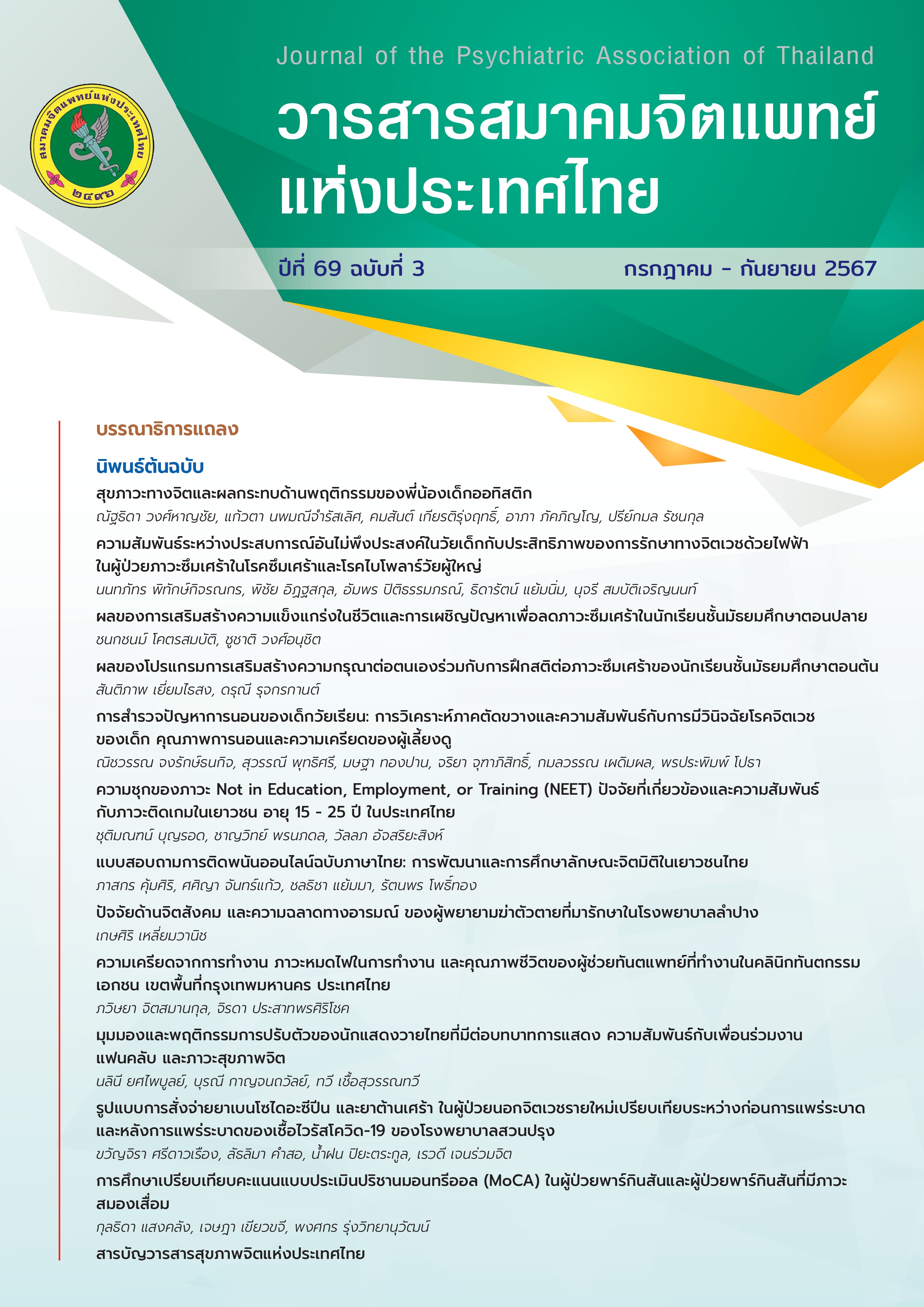แบบสอบถามการติดพนันออนไลน์ฉบับภาษาไทย: การพัฒนาและการศึกษา ลักษณะจิตมิติในเยาวชนไทย
Main Article Content
บทคัดย่อ
วัตถุประสงค์ เพื่อพัฒนาแบบสอบถามการติดพนันออนไลน์ และศึกษาลักษณะจิตมิติของแบบสอบถามการติดพนันออนไลน์ฉบับภาษาไทยสำหรับเยาวชนไทย
วิธีการศึกษา ทำการศึกษาภาคตัดขวางในเยาวชนไทยทั่วไปไม่จำกัดเพศ มีอายุระหว่าง 15 – 24 ปี ระบุว่าตนเองเคยเล่นพนันออนไลน์อย่างน้อย 1 ครั้งในช่วง 12 เดือนที่ผ่านมา ขนาดกลุ่มตัวอย่างมีทั้งสิ้น 200 คน เก็บข้อมูลแบบสอบถามออนไลน์กับกลุ่มตัวอย่างแบบแบบลูกโซ่ เครื่องมือที่ใช้ในการวิจัยคือแบบสอบถามออนไลน์ ประกอบด้วยแบบสอบถาม 3 ส่วน ได้แก่ 1) แบบสอบถามข้อมูลทั่วไป 2) แบบสอบถามการติดพนันออนไลน์ในเยาวชนฉบับภาษาไทย จำนวน 11 ข้อ และ 3) แบบประเมินปัญหาพนันฉบับภาษาไทย (PGSI) จำนวน 9 ข้อ ทำการศึกษาความเชื่อมั่นโดยวิเคราะห์ความมั่นคงภายในด้วยสัมประสิทธิ์อัลฟาของครอนบาค ศึกษาความตรงเชิงโครงสร้างด้วยการวิเคราะห์องค์ประกอบเชิงยืนยัน และตรวจสอบความตรงเชิงเหมือนด้วยการศึกษาสหสัมพันธ์กับแบบประเมินปัญหาพนันฉบับภาษาไทย
ผลการศึกษา กลุ่มตัวอย่างมากกว่าครึ่งเป็นเพศหญิง (ร้อยละ 55) มีค่าเฉลี่ยอายุอยู่ที่ 20 ปี กำลังศึกษาระดับปริญญาตรี (ร้อยละ 81) ประสบการณ์เล่นพนันออนไลน์ 3 ลำดับแรก เช่น ไพ่ผสมสิบ (ร้อยละ 21.89) รองลงมาเป็นบาคาร่า/ป๊อกเด้ง (ร้อยละ 20.12) และทายผลกีฬา (ร้อยละ 14.50) สำหรับโมเดลของแบบสอบถามการติดพนันออนไลน์ฉบับภาษาไทยสำหรับเยาวชนพบว่ามีองค์ประกอบเดียวและมีความสอดคล้องกลมกลืนกับข้อมูลเชิงประจักษ์ดี (χ2 = 67.01; df = 39; relative chi-square = 1.72; p=.003; RMSEA = .06; RMR = .03; GFI = .95; AGFI = .91; TLI=.96; CFI = .97; PGFI = .56) มีค่าความเชื่อมั่นทั้งฉบับเท่ากับ .90 แบบสอบถามการติดพนันออนไลน์ฉบับภาษาไทยสำหรับเยาวชนมีความสัมพันธ์เชิงบวกกับแบบประเมินปัญหาพนันอย่างมีนัยสำคัญทางสถิติ (p<.01) โดยที่มีค่าสัมประสิทธิ์สหสัมพันธ์ (rxy= .84) อยู่ในระดับสูงมาก แสดงถึงความตรงเชิงเหมือน
สรุป แบบวัดมีความตรงเชิงโครงสร้าง ข้อคำถามทุกข้อสามารถวัดออกมาได้ 1 มิติ ซึ่งตรงกับโมเดลการศึกษาต้นฉบับ ทั้งนี้มีความเชื่อมั่นและความตรงเชิงเหมือนอยู่ในเกณฑ์ดีมาก ดังนั้นแบบสอบถามการติดพนันออนไลน์สามารถนำมาใช้กับเยาวชนไทยได้
Article Details

อนุญาตภายใต้เงื่อนไข Creative Commons Attribution-NonCommercial-NoDerivatives 4.0 International License.
บทความที่ส่งมาเพื่อพิจารณา ต้องไม่เคยตีพิมพ์หรือได้รับการตอบรับให้ตีพิมพ์ในวารสารฉบับอื่น และต้องไม่อยู่ระหว่างการส่งไปพิจารณาในวารสารอื่น
เอกสารอ้างอิง
Calado F, Griffiths MD. Problem gambling worldwide: an update and systematic review of empirical research (2000–2015). J Behav Addict 2016; 5(4): 592-613.
Kaewmanee P, Pongloe P. Effecting factors toward attitudes and behaviors regarding gambling activities of undergraduate students: a case study of Burapha university, JEMRI 2021; 3(2): 135-48.
Langka W. Online gambling behavior: causal factors, processes, behavioral effects and guidelines for helping students who are addicted to online gambling for guidance teachers in educational institutions. Bangkok: Centre for addiction studies; 2021.
Lexsreenak K, Ploydanai N, Sukchotrat V. Gambling behavior among adolescent and youth in Thailand: a case study of young people’s gambling behaviours in Bangkok area. KKU Res J (GS) 2012; 12(4): 132-46.
American Psychiatric Association. Diagnostic and statistical manual of mental disorders 5th Ed. Washington DC: American Psychiatric Publishing; 2013.
Koomsiri P, Worawong W, Kongpon T, Suksamphan N, Kaewsawang T. The correlation between gambling game and community mental health problem. Psy Journal 2022; 12: 39-49.
Likritalakul T, Koomsiri P, Disayawanwat P, Yamma C, Nantasan S. Mental health and problem in gambling on helpline 1323’s clients. J Psychiatr Assoc Thailand 2020; 65(2): 131-40.
Saipin N. Gaming addiction behavior, virtual goods purchases in game, loot boxes and gambling in online game of Thai adolescent. Bangkok: Centre for Addiction Studies; 2020.
Koomsiri P, Dachaphanyawat S, Kamkaew T, Rattanatrai N, Likritalakul T, Wiang-Non K, et al. Development of problem gambling severity index Thai version. TNCP2017: Bangkok: Ramkhamhaeng University 2017: 589-608.
González-Cabrera J, Machimbarrena JM, Beranuy M, Pérez-Rodríguez P, Fernández-González L, Calvete E. Design and measurement properties of the online gambling disorder questionnaire (OGD-Q) in Spanish adolescents. J Clin Med 2020; 9: 120.
Hair JF, Black WC, Babin, BJ, Anderson RE, Tatham RL. Multivariate data analysis 6th ed. New Jersey: Prentice Hall; 2006.
Ngamyan A. Due to the formula of Yamane. JBA 2011; 34(131): 46-60.
West SG, Finch JF, Curran PJ. Structural equation models with non-normal variables: problems and remedies. In: Hoyle RH, Ed., Structural equation modeling: concepts, issues, and applications. Sage, Thousand Oaks; 1995: 56-75.
Pengruck L, Boonphak K, Sisan B. Early childhood education: a confirmatory factor analysis concerning Thai administrators’ creative administration. APSSR 2019; 19(1): 17-32.
Hair JF, Black WC, Babin BJ, Anderson RF. Multivariate data analysis: a global perspective 7th ed. New Jersey: Pearson Prentice Hall; 2010.
Joreskog KG, Sorbom D. LISREL8: user’s reference guide. Mooresville: Scientific Software; 1996.
Hu L, Bentler PM. Fit indices in covariance structure modeling: sensitivity to under parameterized model misspecification. Psychol Methods 1998; 3(4), 424-53.
Kelloway EK. Using M-plus for structural equation modeling: a researcher's guide. Sage Publications; 2015.
Schumacker RE, Lomax RG. A beginner’s guide to structural equation modeling 3rd ed. New Jersey: Lawrence Erlbaum Associates; 2010.
Segal DL, Coolidge FL. Reliability In: Bornstein MH, The SAGE Encyclopedia of Lifespan Human Development. Thousand Oaks: SAGE Publications; 2018.
Evans JD. Straightforward statistics for the behavioral sciences. Brooks/Cole Publishing; Pacific Grove, Calif; 1996.
World Health Organization. International statistical classification of diseases and related health problems 11th ed. Geneva, Switzerland: World Health Organization; 2019.
Griffiths MD. A “components” model of addiction within a biopsychosocial framework. J Subst Use; 2005; 10, 191–7.
Lesieur HR, Blume SB. The South Oaks gambling screen: a new instrument for the identification of pathological gamblers. Am I Psychiatry 1987; 144(9): 1184-8.
Kim SW, Grant JE, Potenza, MN, Blanco C, Hollander E. The gambling symptom assessment scale (G-SAS): a reliability and validity study. Psychiatry Res 2009; 166(1): 76-84.
Pratumviang C, Danuwong C, Thani, S. Situation and affecting towards gambling of student in Ubon Ratchathani Rajabhat university. UMT Poly Journal 2018; 15(2): 60-74.
Saipin, N. Gaming addiction behavior, virtual goods purchases in game, loot boxes and gambling in online game of Thai adolescent. JBS 2021; 27(2): 20-38.
Srikeawchuang T, Suebpongsiri S. Motivation for online gambling addiction. RPCAJCSC 2022; 4(1): 71-84.


